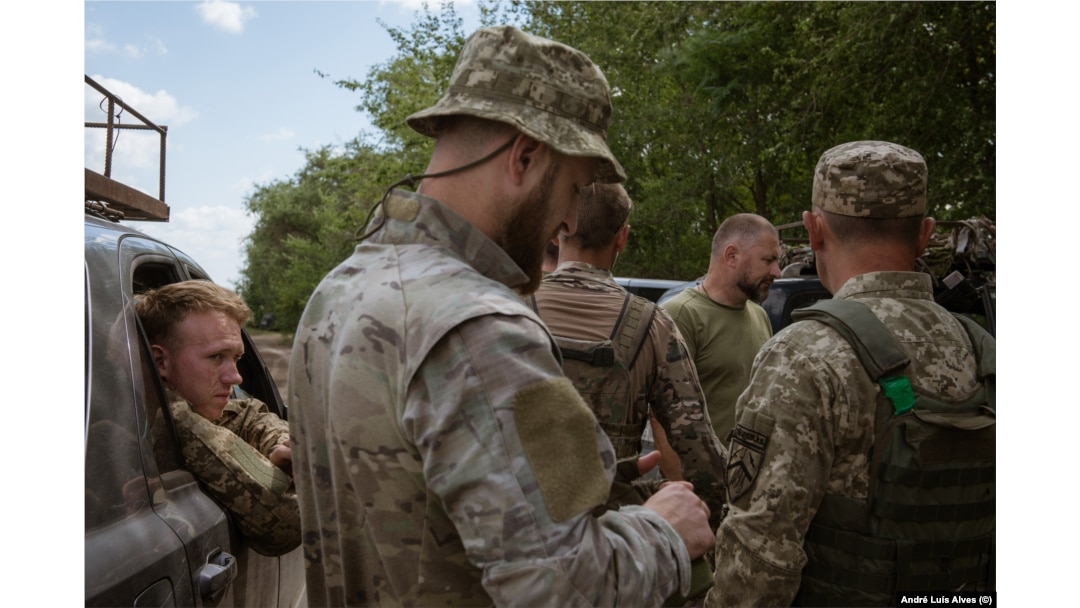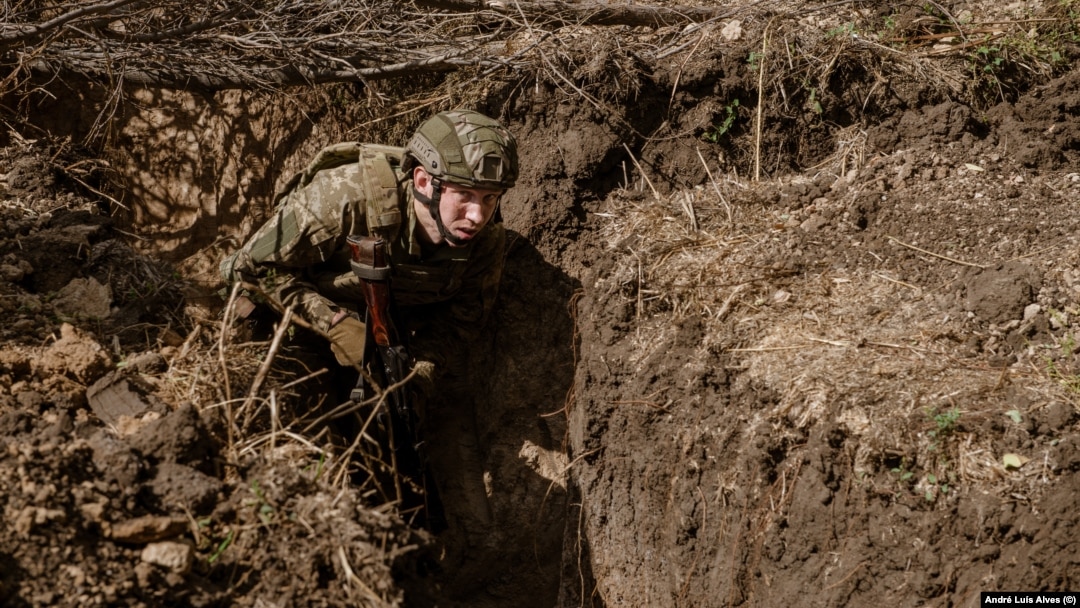HULYAYPOLE DISTRICT, Ukraine -- "We see them, they see us, and only the animals in between our trenches move once in a while," said Grizzly, the deputy commander of a unit defending several positions on Ukraine's southern front.
Some of his soldiers had just returned from the so-called fire trench -- the first line of defense, and also a jumping-off point for a potential attack -- and joined others to train in a safe position a few kilometers deeper in Ukrainian-held territory.
They were assigned various roles during a drill simulating a trench assault, a type of warfare that is at the heart of Ukrainian attempts to break through Russian defenses. Some 30 men ran, crawled, jumped, hid, and covered their comrades under a burning sun typical of summer in the Zaporizhzhya region.
As the exercise concluded, the instructor, who did not want his name published, congratulated the tired and sweat-soaked soldiers, saying, "There's never too much training, but you all have long been ready."
The mixture of fighting and training -- and waiting -- has become a daily routine for soldiers from the 62nd Battalion of the 103rd Brigade, most of whom volunteered to fight at the beginning of Russia's full-scale invasion in February 2022. A year and a half later, many of them speak of exhaustion as they try to adapt to the prospect of a prolonged war whose end is not in sight.

The 62nd Battalion was initially formed as a territorial defense unit in Lviv. Most of its members volunteered to fight.
Trenches And Drones
Yuriy, 31, and Bohdan, 22, have served as infantrymen for over a year now.
Yuriy is trying to cope with separation from his wife and young son, who have found refuge in Canada. He has seen them only once since he joined up -- when he was recovering from a wound. Bohdan left university to join the army and hopes to return to his studies. But both must continue their service -- there is no time limit to it under the general mobilization legislation adopted shortly after the invasion.
"War turns a man into an animal," Yuriy said. He told RFE/RL that he had enough of close combat, and decided to become a drone operator in order to "kill enemies more efficiently." Bohdan said that he finds flying a drone "much more interesting" than spending days in a trench.
Yuriy (right) learns to operate a newly acquired drone.
Like many units in Ukraine, their battalion has received commercial drones built for aerial photography via a crowdfunding campaign and modified them for military use. "It's a cheap serial production that you can easily modify like Lego blocks," Bohdan said.
The buzzing of the drones flying over sunflower fields and tree lines that offer soldiers protection has become a constant feature of the war. Drones are often jammed by Russian electronic-warfare systems, Bohdan says, but some manage to fly over enemy lines and drop bombs.
According to Oleksandr, deputy commander of the 102nd Brigade, a unit deployed in the same area, who came to the training position to meet with the soldiers and assemble a group for a drone strike, drones are also crucial for gathering intelligence and correcting artillery fire.
'The Advantage Is Ours'
The front line around Hulyaypole hasn't moved much in over a year, Oleksandr told RFE/RL. The Ukrainian forces deployed here are holding back Russian attacks and exerting pressure on Russian units that could otherwise be used on sections of the front where the fighting is heavier.
After Ukrainian forces handed Russia several major setbacks last year, the war ground on over the winter and Kyiv launched a much-anticipated counteroffensive on parts of the 1,200-kilometer front in the east and south in early June.
Initial attempts to break through strongly fortified Russian defensive lines had limited success, and the pace of Ukrainian progress has been slow.
SEE ALSO: Ukraine Counteroffensive Slogs Forward. The West Frets."The enemy is strong, well-prepared, well-equipped, and built an unprecedented defensive system," Oleksandr said, adding that both sides gather extensive intelligence and are aware of each other's movements.
Despite hopes placed on an influx of tanks and armored vehicles delivered by Ukraine's allies, he says, artillery continues to play a crucial role in the war on the southern front -- and more time is needed to prepare for a push southward.
The current status quo, Oleksandr says, lets Russian forces shell heavy equipment the instant it is brought onto the battlefield, and their advantage in planes and helicopters makes significant movement forward risky for Ukrainian troops.
Oleksandr, deputy commander of the 102nd Brigade, came to a training position to meet with the troops and assemble a group for a drone strike.
Still, he said, "Every day, we destroy their artillery, ammunition depots, and logistics, so overall the advantage is on our side.... The weather in the south is good until late October, and fighting after that is also possible."
No Cakewalk
Twelve weeks into the counteroffensive, many in the West have grown worried about the prospects of Ukraine's push toward the Azov Sea, whose main goal is to cut the "land corridor" that Russian forces use to supply and fortify the occupied Crimean Peninsula.
Without citing specific sources, The Wall Street Journal reported on August 24 that "U.S. and Ukrainian officials have been engaged in an intense behind-the-scenes debate for weeks over the strategy and tactics for reviving Kyiv's slow-moving counteroffensive." It said the Ukrainian commander in chief, General Valeriy Zaluzhniy, has told U.S. officials that his forces are close to a breakthrough.
Ukrainian authorities are urging patience and stressing the gains made so far -- most recently the recapture of Robotyne, a village southwest of Hulyaypole, and in Urozhayne, to the east. Ukrainian troops have breached the first line of Russian defenses at those locations, and reports of Russia bringing in more troops suggest that a breakthrough is possible.
Bohdan left university to join the army. After over a year in the infantry, he switched jobs and became a drone operator.
In an interview with RFE/RL's Ukrainian Service, Oleksiy Danilov, secretary of the National Security and Defense Council, said that the task of liberating all Russian-occupied territory was no "cakewalk" and that advances on the front were being "carried out in a way that allows us to keep the maximum possible number of our soldiers alive and unharmed."
As the prospect of a prolonged war looms over Ukraine, concerns about the number of casualties have grown. President Volodymyr Zelenskiy recently acknowledged that the military is voicing the need to mobilize more soldiers and vowed to "restore order" in military enlistment offices and military medical commissions amid evidence of corruption.
SEE ALSO: Amid Corruption Scandals And Mounting Problems, Ukraine Vows To Shake Up The Military Enlistment System. It's A Tough Task.'Reaching The Limit'
For now, the grinding war is redefining every aspect of life in towns and villages along or adjacent to the front line that are full of soldiers coming back from battle for a break -- restaurants are crowded with them, markets do a brisk trade in military clothing, and mechanics keep busy fixing off-road vehicles used by the military.
The road from the city of Zaporizhzhya to Pokrovske, north of Hulyaypole -- part of a major route for supplies to the southern front -- is filled with run-down, speeding cars, jeeps, and trucks carrying men, weapons, ammunition, and food supplies.
Speaking over dinner in a village hut turned into military housing, Grizzly told RFE/RL that his view of the future was "less bright every month I keep fighting."
Grizzly, 34, whose real name is Roman, was an entrepreneur in the metalworking industry before he joined the army along with 25 of his 100 employees. It's not his first time at war: In 2015, he was mobilized to fight in the Donbas, where the conflict stoked by Russian incitement of anti-Kyiv sentiment erupted the previous year.
His unit has strong support from families of its members and from others in western Ukraine, as the 62nd Battalion was initially formed as a territorial defense unit in Lviv shortly after the start of the full-scale invasion. He said he had donated over $40,000 to the unit.
By the time it was transferred to Hulyaypole two months ago, its soldiers had already been through a lot: They took part in the fighting that drove Russian forces out of the northern Sumy region, in the defense of Kharkiv and the liberation of nearby Kupyansk, and in a deadly standoff in the Serebryanskiy Forest near Kreminna, in the Luhansk region, as well as other missions there.
"We have suffered substantial losses. Dozens have died, dozens have been wounded, some were transferred to the rear, and some abandoned the unit," Grizzly said. Some of the soldiers got out by obtaining fake documents or lying to him about their personal situation, he added.
Grizzly, the 62nd Battalion’s commander, prepares to leave for a position on Ukraine’s Independence Day.
Eighteen months after the full-scale invasion, the "patriotic potential of Ukrainian society is reaching the limit," and cases of corruption in the army leave many soldiers disillusioned, he said. "Many of my boys are brave and motivated to fight, but there are simply not enough of us."
On August 24, Grizzly woke up at 5 a.m. and went to join his soldiers at the unit's position, bracing for battle after he received information that the Russians would seek to escalate the fighting on the front on Ukrainian Independence Day.
"We all hope Zaluzhniy has a joker in his hand," a wild card that could tip the balance, he said the night before. "And what if the war drags on? I hope we make through it alive."


